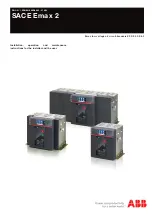
Instruction Book
Effective: February 2007
Page 39
I.B. 8295A61H07
For more information visit:
www.EatonElectrical.com
as the auxiliary switch contacts in the breaker. The
MOC switch operator is located on the bottom of the
Series 20 breaker element (Figure
6-6
)
.
When an MOC switch is required, it is the customer’s
responsibility to provide the proper interface with the
Series 20 MOC operator. Refer to the Series 20 outline
drawing (Figure
1-2
)
for specific details as to the
operator’s location and amount of travel.
6-5 SERIES 29 BREAKER ELEMENT INTERFACES
The Series 29 breaker element can be used for drawout
or fixed breaker applications. As supplied by Cutler-
Hammer, the breaker element is of the fixed breaker
configuration and must be altered and added to by the
customer for use as a drawout breaker. Specific
electrical and mechanical interfacing details relative to
the breaker element are provided in this section to assist
the customer with its specific application and/or retrofit
of the Series 29 breaker element.
6-5.1 INITIAL INTERFACING STEPS
• Read and understand paragraphs 6-1 and 6-2 in their
entirety before proceeding.
Figure 6-6 Series 20 Showing Bottom Accessed
Interlocks and MOC Operator
•
Review the details presented in Table
1.1
and Figures
1-3, 3-5, 3-6, 3-7
and
5-1.
•
Review the Series 20 specific control scheme (Figure
6-2
) and the outline drawing (Figure
1-3
) presented
earlier before proceeding.
6-5.2 ELECTRICAL INTERFACES
Secondary control access is provided by 2 12-point
secondary control terminal blocks located at the bottom
of the breaker element (Figure
3-5
).
The Series 29
control scheme indicates which points are used for
breaker operation and which are available for customer
use (Figure
6-2
).
6-5.3 MECHANICAL INTERFACES
The customer is responsible for providing all required
mechanical interfaces to insure that the Series 29
element is properly installed and applied in a fixed or
drawout configuration. Depending upon the final applied
configuration, the customer is responsible for but not
limited to the following:
•
An appropriate truck and levering mechanism for
drawout breaker designs.
•
The appropriately sized and secured primary
connections for fixed or drawout designs. Refer to the
following specific details entitled “Primary
Connections.”
•
The entire cell structure for drawout configurations with
appropriate interlocks, levering mechanisms, barriers
and circuit breaker interfaces to insure compliance
with applicable ANSI Standards.
•
Properly designed and proven by test interfaces
necessary to operate Series 29 breaker element
supplied interlocks and auxiliary switch operators, if
required.
Primary Connections
The customer is responsible for providing all properly
sized primary connections to the VCP-WR breaker
element, whether the connections take the form of cable
or bus bar (Figure
6-7
)
.
The Series 29 outline drawing
(Figure
1-3
) provides breaker element primary
connection details, such as primary spacings and hole
patterns.
Floor Tripper Interlocks (Drawout Designs)
Open and closing floor tripper interlocks are operated by
the interaction between the floor tripper rollers on the
bottom of the breaker element and the carriage or cradle
assembly provided by the customer (Figure
6-8
).
Содержание Cutler-Hammer 150 VCP-WR 1500
Страница 2: ......















































